When describing fiber connector, we often use terms like “LC UPC simplex single-mode fiber connector” or “ SC APC simplex single-mode fiber connector”. Then have you ever wondered what “UPC” and “APC” stand for? Or is there any difference between them? This is what we are going to talk about in this article.
Firstly, let’s take a look at how connectors evolve from the original flat fiber connector into the physical contact (PC) connector and then onto ultra physical contact (UPC) connector and angled physical contact (APC) connector.
When two flat fiber connectors are mated together, a small air gap is left between the two ferrules. This is partly because the relatively large endface of the connector allows for numerous slight but significant imperfections to gather on the surface. However, it is not much use for single-mode fiber cables with a core size of just 8-9 um, hence there naturally comes to the necessary evolution to physical contact (PC) connectors.
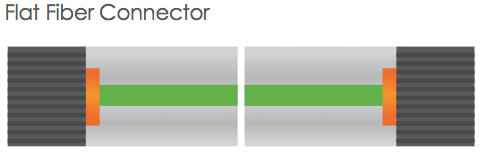
The PC connector is similar to the flat fiber connector but it is polished with a slight spherical (cone) design to reduce the overall size of the endface. Which helps to decrease the air gap issue faced by regular flat fiber connectors, resulting in lower optical return loss (ORL), with less light being sent back towards the power source.
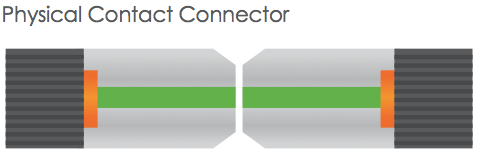
Ultra physical contact connector (UPC) is built on the convex endface attributes of the PC, but with an extended polishing method, which creates an even finer fiber surface finish. This results in lower back reflection (ORL) than a standard PC connector, allowing more reliable signals in digital TV, telephony and data systems, where UPC today dominates the market. UPC connectors do have a low insertion loss, but the back reflection will depend on the quality of the fiber surface and, following repeat matings/unmatings, it will begin to deteriorate.
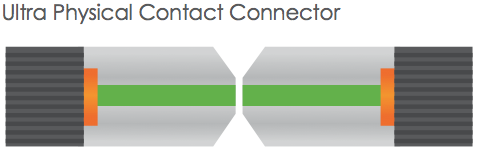
The tendency is that the industry needs a connector with low back reflection, that could sustain repeated matings/unmatings without ORL degradation. And this brings us the angled physical contact (APC) connector.
Although PC and UPC connectors have a wide range of applications, some instances require return losses in the region of one-in-a-million (60dB). Only APC connectors can consistently achieve such performance. This is because adding a small 8-degree angle to the endface allows for even tighter connections and smaller endface radii. Combined with that, any light that is redirected back towards the source is actually reflected out into the fiber cladding, again by virtue of the 8-degree angled end-face. What to mention is that other three connectors are all inter-mateable, whereas the APC isn’t.
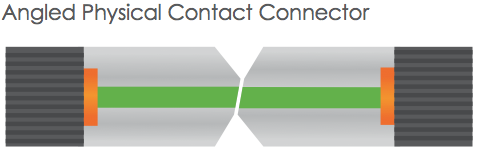
Currently, with UPC and APC connectors dominating the market, these two types are the most commonly seen connectors employed in the fiber optic industry. In this part, we will mainly explain the difference between them. Besides the more obvious difference that UPC connectors are blue while APC connectors are green, the main difference actually lies in the fiber endface.
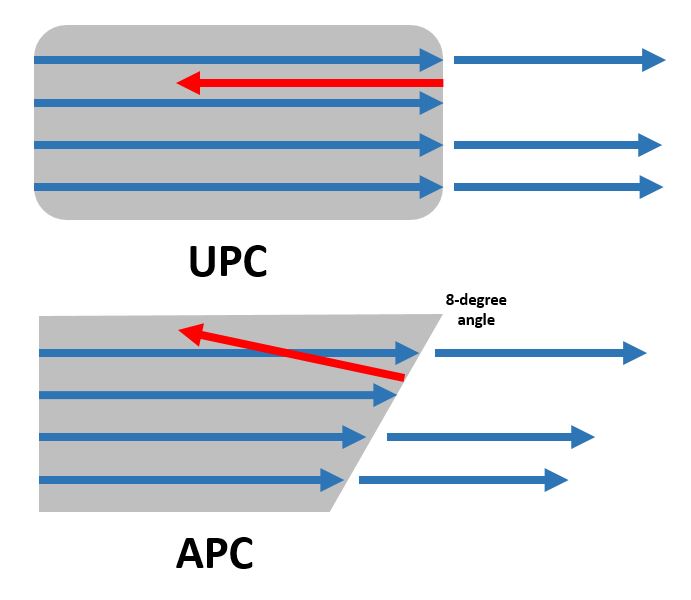
APC connectors feature a fiber endface that is polished at an 8-degree angle, while UPC connectors are polished with no angle. UPC connectors are not exactly flat however, they have a slight curvature for better core alignment. With UPC connectors, any reflected light is reflected straight back towards the light source. However, the angled endface of the APC connector causes reflected light to reflect at an angle into the cladding versus straight back toward the source. This causes some differences in return loss, which is a measurement of reflected light that is expressed as a negative dB value (the higher the value, the better). Industry standards recommend that UPC connector return loss should be -50dB or greater, while APC connector return loss should be -60dB or greater.
With APC connectors being used by most cable companies, other FTTX providers in outside plant applications, and passive optical applications (both GPONs and passive optical LANs). Future higher-speed passive optical networks and other WDM applications that will use higher wavelengths via singlemode fiber will also likely require the reduced return loss of APC connectors. What should be noted is that APC and UPC connectors cannot be mated, in case to cause poor performance or to destroy both connectors. However, when choosing the right connector for your specified application, factors like cost and simplicity should also be considered seriously, not just optical performance. So, it actually depends on the real circumstances and various factors.
It is generally accepted that all of these connector options capture a place in the current market, and we cannot say anyone is better than the others since whether to choose UPC or APC in fact depend on your particular need. Whereas for those applications which high precision optical fiber signaling matters, APC should be the optimum alternative, but for less sensitive digital systems, UPC and APC can both perform equally well.